The new Movie Magic Budgeting – Review
The new Movie Magic Budgeting 10 has, according to Entertainment Partners (EP), been “rebuilt from the ground up”. The main differences with its previous versions are a new interface and a cloud sync feature.
As an entertainment-technology professional, I was really excited to put my hands on this new product. And in light of the recent acquisition of Entertainment Partners by TPG, I think that we can use this release to take a glimpse into the future of the entertainment industry’s behemoth.
Preface
I’d like to start by stating that developing software for the entertainment industry is incredibly difficult. Having worked for a tech startup in the field, I’ve experienced the following difficulties on a day-to-day basis:
- Every client wants something different out of their software. The subtle nuances in operational processes are endless.
- The industry remains “old school”. Convincing professionals to switch product, then training them to use new tools is a long, time-consuming endeavor.
- In order to release a product that serves the part of the industry that really matters, you need strong relationships with multiple unions.
- Most software products need to be built for both desktop and mobile, have excellent UI that allows to keep up the pace with the speed of operations in the field, and also work offline (this is a significant concern with most clients).
- The amount of detail to keep track of, regardless of the product’s focus, is frightening. The award goes of course to HR and Payroll, but you also find monumental complexity in financing, development, set operations, or post production.
- While software companies tend to work 10am to 6pm, the production world is always on. Entrepreneurs who launch a product must provide support at all hours of the day.
This list could go on but I’d like to mention one last reason that makes it incredibly difficult to create new software in our industry:
Entertainment Partners is the standard.
About Entertainment Partners
What EP has done over the last 40 years is no small feat. Although I didn’t personally witness the evolution of their products, it is undeniable that EP’s team has a successful track record releasing countless products and services.
If you want to create a film and Television budgeting software today, your main difficulty isn’t innovation or technical execution. It’s market penetration.
With Movie Magic Budgeting (MMB), Entertainment Partners has achieved total domination over the industry. I have yet to meet a single Line Producer who uses a different product than MMB when dealing with budgets above 100K.
Paradoxically, the public feedback on MMB was not good. Although it was easy to criticize Movie Magic Budget 7 over its ugly interface, I don’t believe that this was really the source of the issues. SmartSheet, a project management tool, shares the same lack in design when it comes to the user interface, but makes it up with an extremely powerful set of features and fantastic user experience.
It’s been several years since the release of MMB 7. For a company of the size of EP, and given the amount of resources and connexions they have acquired, my expectations for MMB 10 were high.
First impressions
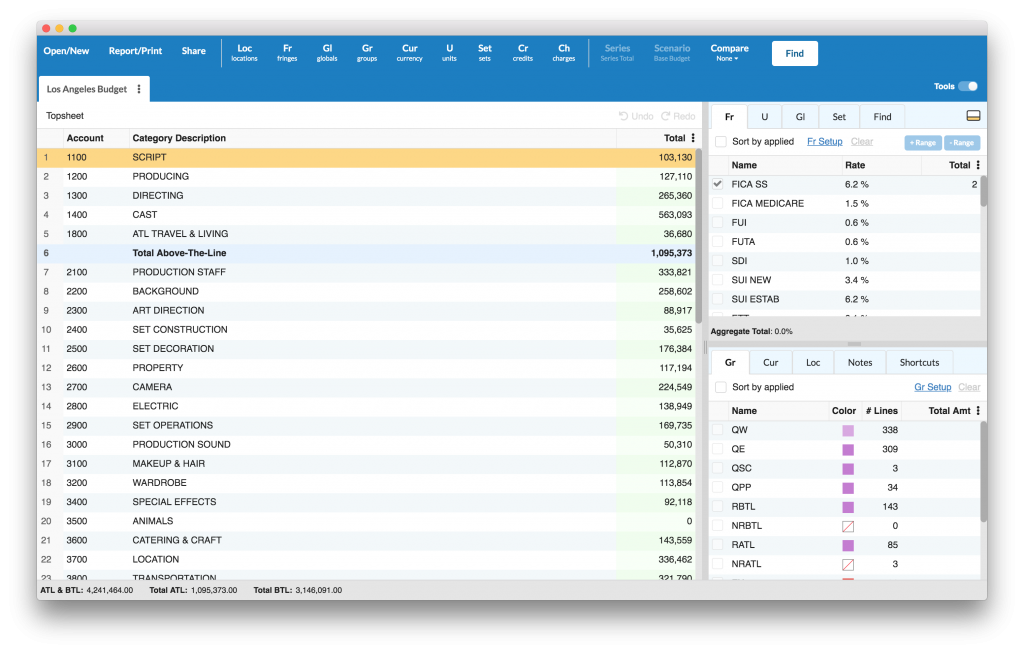
The new Movie Magic Budgeting is much prettier to look at than its predecessor. However, I can’t say that it is ahead or even on par with the current design trends. But, as I mentioned above, I am much more interested in what is under the hood.
At first glance, I couldn’t see any major difference with MMB 7. The menu toggles on-screen showcase the features that MMB 7 users are already familiar with: globals, fringes, units, credits…
This isn’t necessarily bad. As I mentioned in the preface to this post, the production industry isn’t very keen on change. Designing a user experience around familiar concepts is, in my opinion, a clever choice.
“Shortcuts” seem to be the only new menu in this new version. They allow the user to streamline repetitive tasks. This sort of considerations will always get a thumbs up in my book.
Next, I went to look at the “Report/Print” menu.
First symptoms
“What you see is what you print”. This is how the Movie Magic Budgeting overview video describes the reporting interface. Although this looks at first to be a great improvement on MMB7, the reality is that this menu has been completely gutted out.
For the purpose of a project I am currently working on, I had to export a budget with more columns than you usually would. I wanted to save a PDF showing the usual columns plus the fringes, groups, and currencies. And, unfortunately, I couldn’t do this with MMB 10.
Although I could toggle these columns, it was impossible to display all the information without cutting off the data.

I want to acknowledge that my intent was unusual. However, given that this task is possible in MMB 7, I find the issue quite frustrating. The many options available in the print settings are now completely gone.
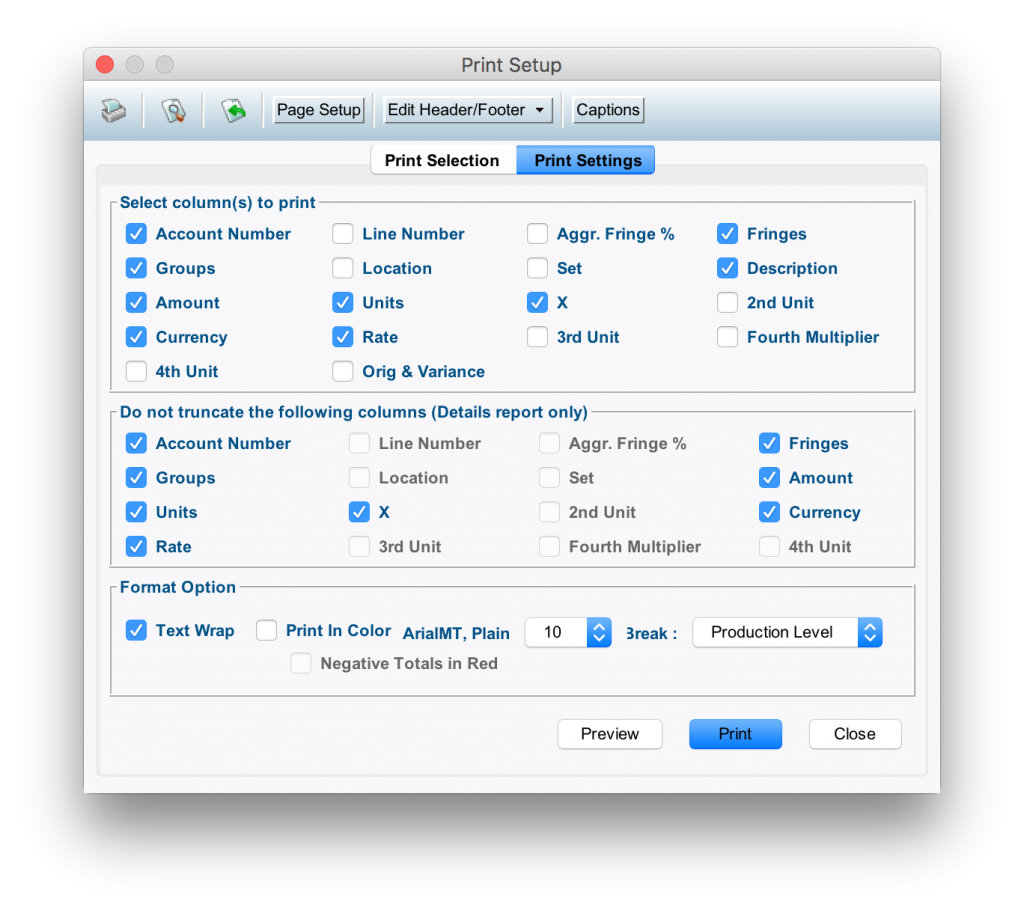
There is a difference betwen making a software less convoluted and removing features that serve a purpose. For me, the new report menu is less functional than the old. And I don’t understand why.
Diagnosis
When I stumbled upon this issue, I first assumed that the error lied with the user: me. I spent time searching through the various sub-menus, then online, looking for guidance to help me find what I was in need of. At the time, I seriously didn’t imagine it possible that MMB 10 could possibly be less robust than MMB 7.
This led me to another disconcerting discovery. At the time I’m writing this post, the support for MMB 10 is quite poor. I found the following issues:
- MMB 10 doesn’t have a PDF manual.
In comparison, the MMB 7 manual is the first result on a Google search. It is 157 pages long and covers almost anything you could ever need. - When MMB 10 is open but no budget is selected, the help menu reveals a “tutorials” submenu. Unfortunately, this links to a broken page.

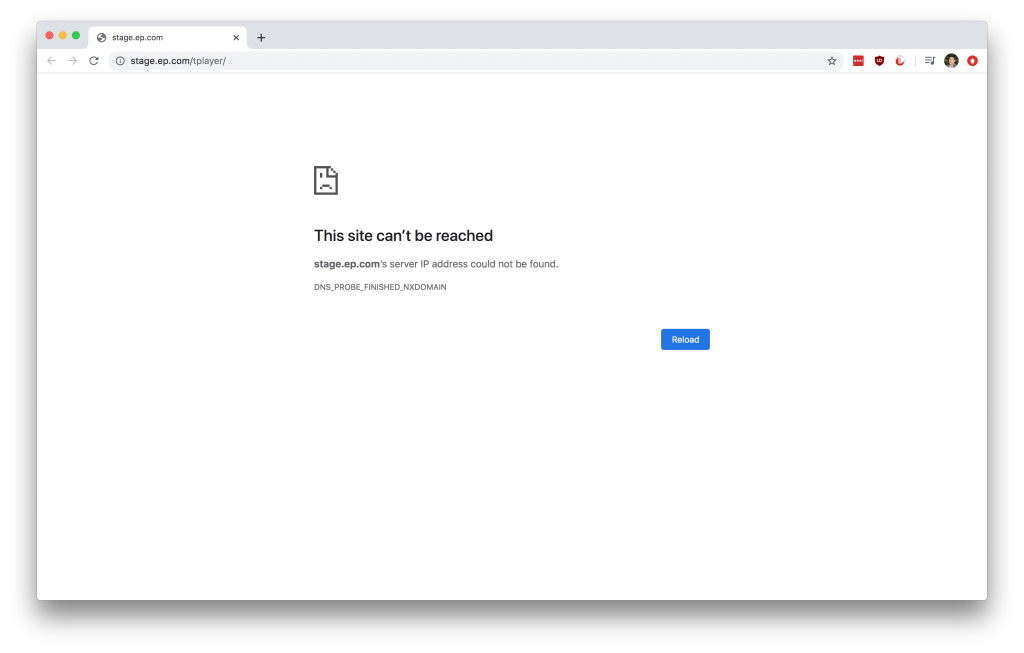
- I’m a persistent Google user, so I kept searching. In the 10.3 release notes, I found the following link:
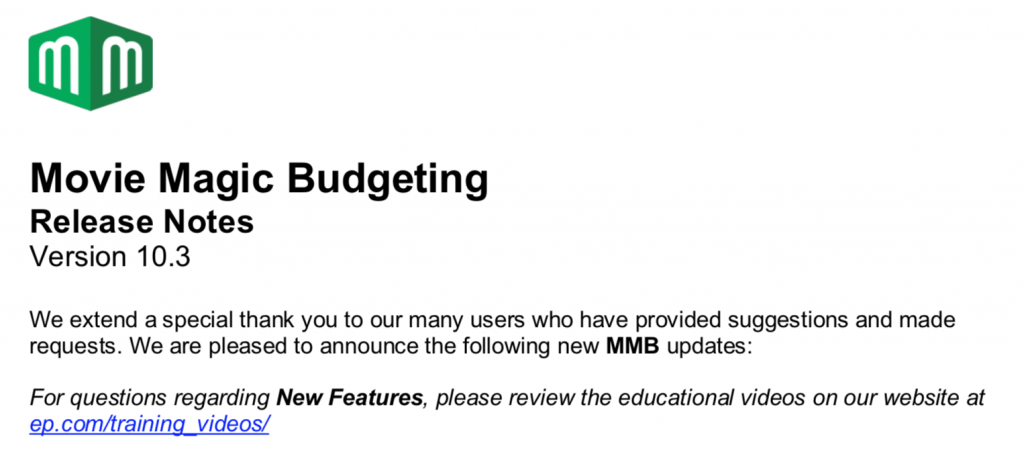
Unfortunately, the link sent me to a…404 page.
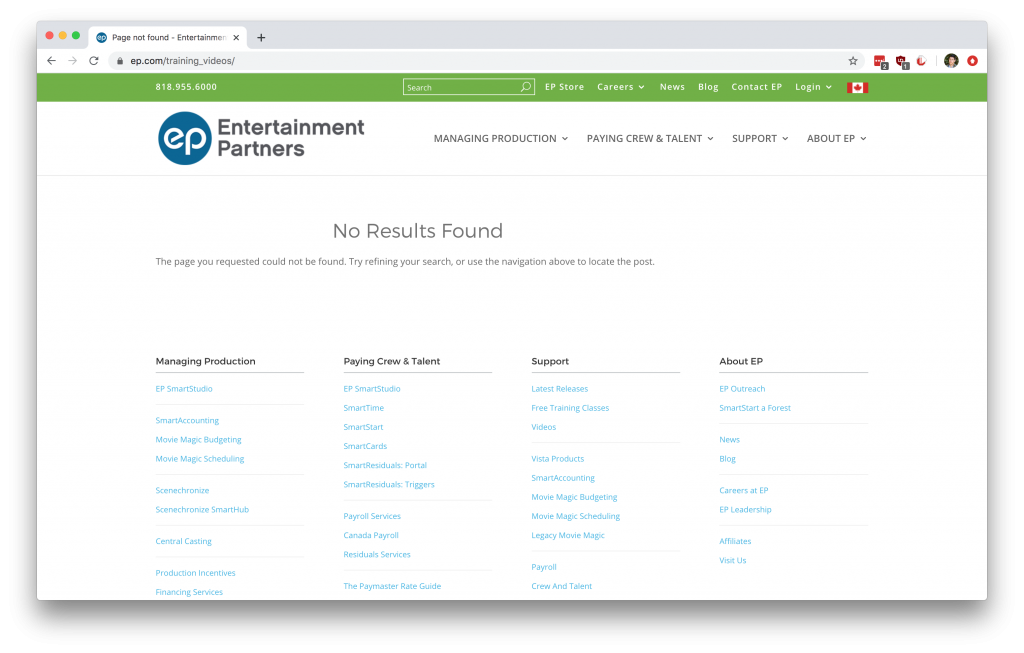
- Since I was on EP’s website, I decided to navigate the support section.
Although every “How To” is dedicated to MMB 7, I did find a series of videos showcasing MMB 10. But Alas, nothing on creating reports.
It’s worth mentioning that EP’s youtube channel is great when it comes to MMB 7. I’ve consulted it on a few occasions to get clarity on some more advanced concepts such as credits caps. Also, shoutout to the team behind the “Legacy Movie Magic Budgeting – Complete Video Training“. I wish all software training videos were done like this.
At this point, I decided to submit a support ticket. I logged in to my.ep.com and looked through the options. Hidden under the “Manage” settings, I found a “How-To’s” link. There, I found a very basic FAQ that read:
“Where are the ‘Report/Print’ settings?”
Victory? Not really. This gave me confirmation that the print settings are indeed “What you see is what you print”. The MMB 7 features are officially gone.
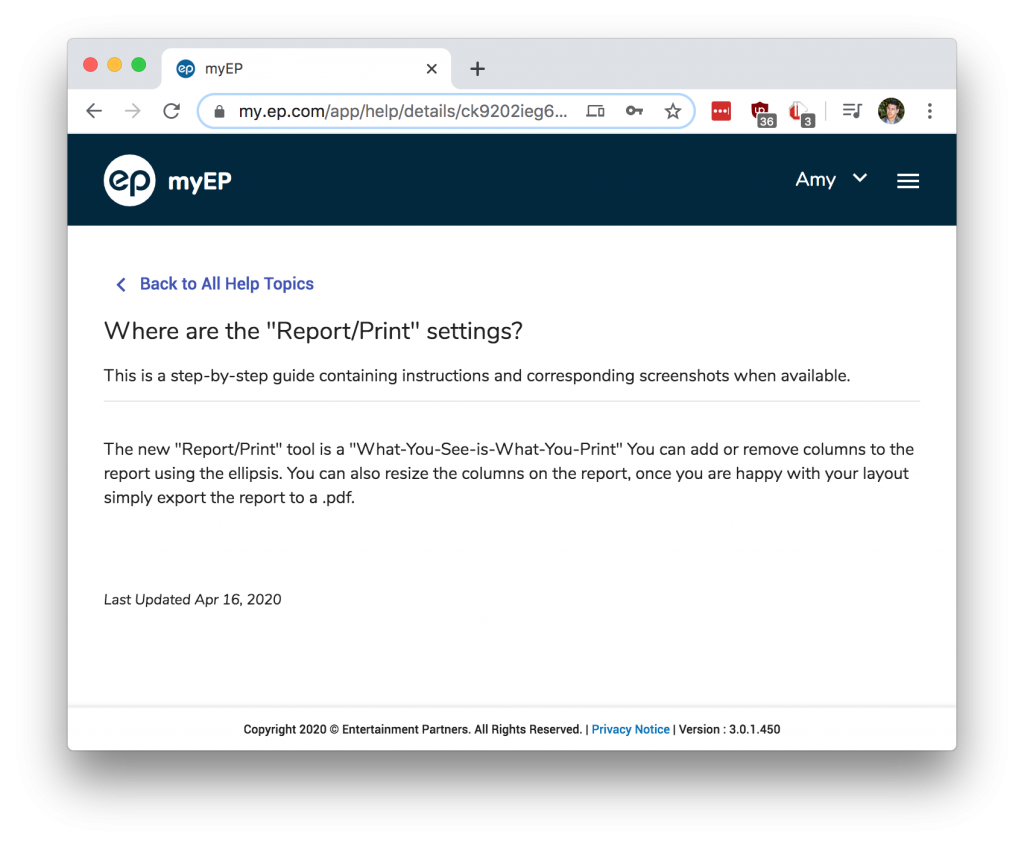
Second opinions
At this point, I would like to remind everyone that Movie Magic 7 was released several years ago. And although the release of MMB 10 coincides with the COVID-19 pandemic, I can’t imagine that this is the cause behind what I can only describe as an unfinished product.
However, I wanted to hear from the rest of the community before putting anything in writing. I had only scratched the surface and since I’m not as experienced as many Line Producers, I didn’t feel entirely qualified to judge this product by myself. The issues I mentioned above are disconcerting but can be fixed. Maybe the core features of MMB 10 are enough to overlook these changes?
One of my connexions forwarded me a post on the FilmTVBudgeting subreddit where user caprock outlines multiple bugs that could easily have been detected during the QA process:
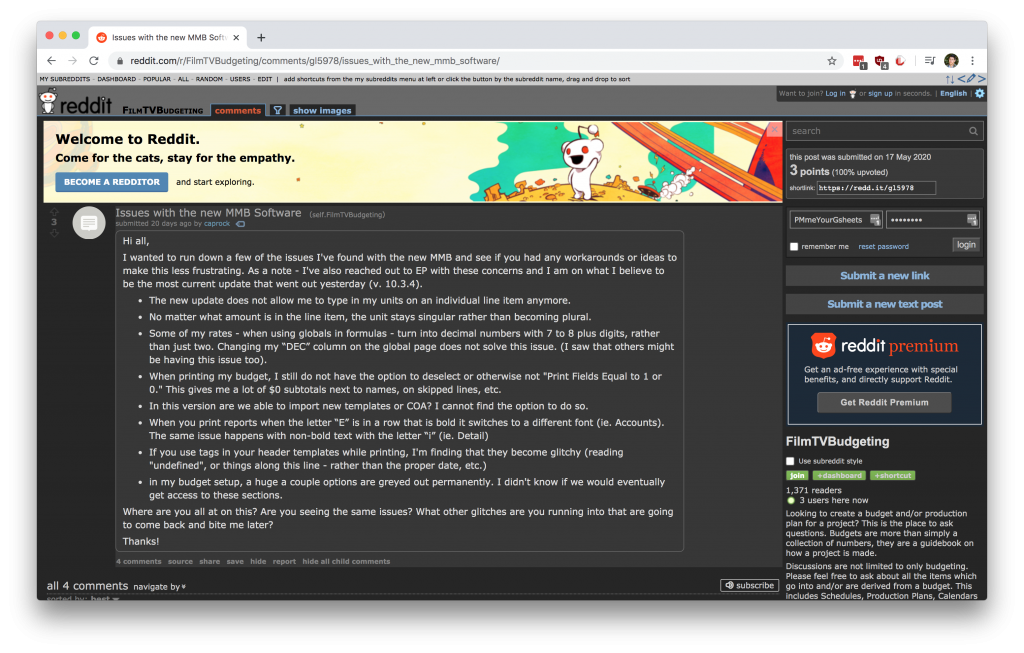
There are also multiple threads on EP’s community portal (theproductioncommunity.force.com) that address bugs as well as feature requests that I’ve wished for myself for a long time.
For instance, one of EP’s Product Sales and Marketing Manager is relaying requests from multiple clients (example 1 / example 2) to have rates and fringe tables available in MMB 10. Apparently, this is “on the roadmap”:


Knowing that EP’s team has put together the incredible “Paymaster rate guide” as well as a detailed list of production incentives worldwide, these requests seem quite reasonable. It’s easy to imagine a version of MMB 10 that would allow the user to import rates, fringes, and applied credits from an updated database.
Finally, I received feedback regarding the technical execution of MMB 10:
I did a pretty thorough review of the new MMB the day it came out and I was tremendously disappointed. While it is moderately more attractive than the old version, it doesn’t provide any new features. And making it cloud-based would be interesting if it increased collaboration – but that isn’t offered either. The issues were separated into two categories – bugs and design flaws – and there were plenty of both. Basic tasks that can be accomplished in MMB 7.7 cannot be done in MMB 10. After a day of testing, it became clear to me that this software was not ready to be used on a show of any size. In short, it’s a dud.
Anonymous Production Manager – Over 20 years of experience
Another connection’s feedback, after reviewing MMB 10:
I had a number of issues, but all seemed like things that were fixable. Sadly, I feel they did not ‘innovate’ as much as ‘update’.
Anonymous Production Manager – Over 30 years of experience
An interesting paradox
As mentioned at the top of this post, I am very well aware of the difficulty to create a product that satisfies everyone in the entertainment industry. And Although this piece may seem like a harsh review of MMB 10, I believe it fair to hold EP’s team to a higher standard than the younger competitors who emerged as part of what I’ll call the “Studio counter-culture”.
And I believe at this point that the success behind MMB’s omnipresence in the Studio world is inherently a matter of culture. The lack of innovation and the poor technical execution of the software itself cannot realistically justify its success across the board.
As video professionals who are participating on a daily basis to the making of highly technical and creative endeavors, and who are quite familiar with the traits that make us consider a project innovative, I find it hard to accept that Movie Magic Budgeting should claim the title of best possible film and TV budgeting software.
Following TPG’s acquisition, Entertainment Partners is no longer an employee-owned company and has since acquired two very interesting tech startups:
- We Got Pop Ltd, an extras casting solution aiming to bring digital vouchers to the background world (a technology I’m very familiar with having worked at Castifi Inc, a direct competitor).
- SyncOnSet, a project management tool that made waves in the wardrobe department over the last few years.
Given that all of Entertainment Partners’ software releases are part of a larger family of products and services, my main fear is to see these companies’ innovative technologies be affected by the same direction that has just delivered us a “botched” MMB 10.
I would love to see Entertainment Partner use its clout with the Studio world and unions to promote the use of new technologies. However, I get the impression that EP is inadvertently doing the opposite, slowing down the pace of progress by being excellent at maintaining its cultural grasp on the industry. As I mentioned above:
Entertainment Partners is the standard.
Clients all around the world are asking for features that make sense and have been within reach for years. When executives within EP’s product team declare that fringes and rate tables are on the roadmap for MMB 10, I can’t help but be skeptical. Where does the difficulty lie in creating this feature, especially for a company that has been around for decades and has already released seven versions of the same software? We know that the data has already been compiled, which is the most difficult part of the whole project.
At this point, I wouldn’t care if these add-ons had come at a premium on top of the base subscription on the MMB 10 release day. I would simply like to have them. Without features that leverage EP’s wide reach in the industry, MMB is no more than a spreadsheet. I understand that the film and TV budgeting world isn’t as big a space as let’s say the general project management, but for $29.99 per month (or the discounted $239.88/year), I would like features that can’t be recreated in Google Sheets within a few hours. For comparison, my Adobe Premiere Pro license costs me $20.99 per month.
Recovery
There are multiple futures ahead of us, and many of them are good for everyone, including EP, its clients, and the industry as a whole.
I’m hoping that Entertainment Partners will start listening to the criticism around Movie Magic Budgeting. Software is a fast-moving industry, and with a few adjustments, MMB 10 could become a truly revolutionizing product. The integration possibilities with EP’s other solutions alone have the potential to create a true, complete production management solution, something that many startups are failing to create from the ground up, and understandably so.
If progress can’t come from within EP’s team, I hope that the leadership can change their current stance and contribute to a better future of the industry by opening the doors to third-party developers through better import/export features and even APIs. As a cloud software, MMB 10’s potential could explode by connecting to rental houses, platforms like ShareGrid, local film offices, etc…
Just like the removal of basic features in MMB 10 prevented me from doing my work with ease, I recall having the same type of issue almost ten years ago while working as an Assistant Director. I had to export my breakdown from Movie Magic Scheduling into various pdf files, then convert them to text in order to import them as a delimited file into the Casper Excel template.
I can’t say with certainty why these limitations are in place across EP’s products, but the combination of this issue with the lack of innovation from the product team creates a situation where the whole industry moves slower.
If you ask me whether there is room for a new budgeting software solution in our industry, my answer is mixed. There clearly is a place for something more elaborate than MMB, the technology and partners to accomplish the task already exist, but I don’t see how a startup could penetrate the market as long as Entertainment Partners maintains its position.

3 Comments
Paul Zagoridis · June 22, 2020 at 9:05 am
Oh how I remember the MMB MMS to Casper dance. I first tried it 7 years ago and gave up 3 years ago.
The lack of EP’s developer responsiveness is the main reason I suspect the Australian film and TV industry has moved away from EP products. Audit for government rebates and offsets is in spreadsheets and PDF forms. At least those look the same.
Then again Australia is a drop in the ocean.
Thomas Mattinson · November 22, 2020 at 1:02 pm
I’ve been using MMB since the early 1990’s. I’ve spent more cash on upgrading this software than any other throughout my career. Ironic when in reality the program has hardly changed in that time while the film and television industry has gone through multiple revolutions in both production and distribution. I’ve not even attempted to start with MMB 10. Having to subscribe to software I’ve owned for 30 years without any major benefit is insulting EP! I think, as I’ve mentioned on EP’s Facebook page, if you can write, record, edit and distribute a film on a mobile device, it’s a poor show that you can’t budget on it! And we’ve all be storing our files in the cloud for some time …….
Stacey · November 24, 2022 at 8:02 pm
A little late on the reply to this email but still wanted to chime in regardless. I’ve used both and really “hate” (harsh but true) what EP has become since the acquisition. MMB7 is a great product and it’s standalone! I don’t trust my data in the cloud, sorry I’m not going to do it. Our budgets have “no quote deals” and to upload them to a cloud with a potential hack threat is something I’m not willing to risk.
The cloud software was the worst idea ever. They should have had it as an option but not a requirement. The annual fee should only apply to cloud usage (optional) not the software. I’m sticking with MMB7!